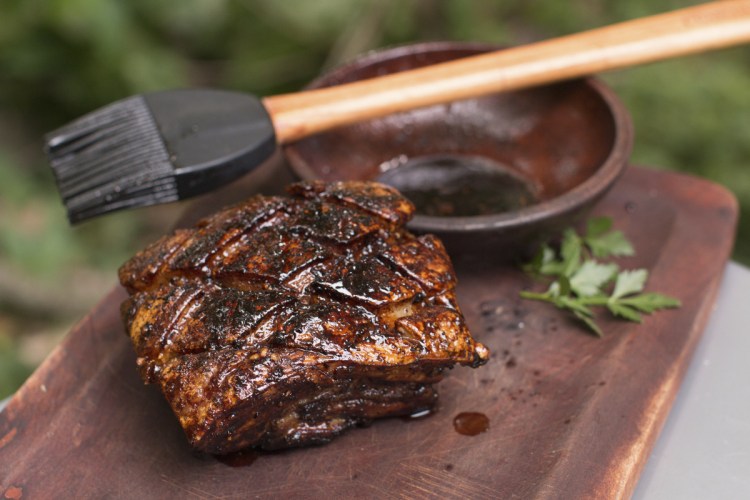“Grill Fire: 100+ Recipes & Techniques for Mastering the Flame.” By Lex Taylor. Sterling Epicure. $24.95
My wife and I like to go camping with our camper, and when we visit parks around the state, we like to try new recipes – especially if we can make them on the grill. That’s what attracted us to “Grill Fire: 100+ Recipes & Techniques for Mastering the Flame” by Lex Taylor.
I always use a gas grill, but for a while now, I’ve not so secretly coveted a charcoal grill. Now I can cross it off what my wife calls my “caveman bucket list,” because this book gave me an excuse to go out and buy one and take it for a test run.
The “Grill Fire” will work for gas grills, Taylor writes in his introduction, but that’s definitely not his focus or his passion. As he writes, “the idea I want to get across in this book is that (gas grills, digital thermometers and heatproof meat-handling gloves) are totally unnecessary and distract from the elemental art of grilling, the understanding of wood, the appreciation of steel, the managing of fire and food.” The first chapter also includes a section on “Grilling over a Campfire.”
The book is divided into 10 chapters, which run the gamut from recipes for red meat, poultry, seafood, and salts and rubs to sections on drinks and grilling basics. There are plentiful pictures for the recipes themselves plus a sprinkling of photographs of people enjoying cooking and eating outdoors.
Taylor gives recipes for dishes you’d expect in a book like this, say classic burgers, ribeye steaks and Honey-Mustard Barbecue Sauce, and also for some you wouldn’t, say gravlax or beignet buns that he substitutes for the usual hamburger buns. The recipes are global in scope – think Bahn Mi Hot Dog or Mexican Bulgogi Drumsticks – and while plenty make for casual summertime eating, others, like Whole Duck with Honey and Cantaloupe, go more upscale.
The book is easy to follow and use – so much so that even if you haven’t used a charcoal grill in years, like me, you can’t go wrong.

I decided to test Bacon Steaks, a recipe that called for pork belly. Heads up, you probably aren’t going to find this cut at Shaw’s. My wife secured it at Great East Butcher Co. in South Portland.
We invited some folks to be our taste testers. The recipe was very simple. I scored the meat and seasoned it with salt and pepper, and the grill did the rest. After the meat rested, as outlined in the recipe, we dug in. Everyone loved it! The Bacon Steaks were tender, moist and very tasty. Some folks said it reminded them of old-time BBQ. A big success!
(Later on, I read in the book’s acknowledgments that Taylor loves this cut, too. He wrote: “Thank you, my dear wife, Gladys, who reminds me daily that it’s not okay to incessantly cook pork belly. You have taught me how to compromise.”)
With Labor Day weekend here, I am sad to see that the season for grilling is winding down, but we hope to squeeze in another recipe from this book before the snow flies.
BACON STEAKS
You will need a spray bottle and a meat thermometer to make this recipe.
Makes 4 steaks or about 40 cubes for appetizers
3-pound pork belly with skin on
2 tablespoons sea salt
2 tablespoons coarse black pepper
Water or apple juice
1. Bring the pork belly steak up to room temperature.
2. Bring the grill up to high heat with coals and have some wood chips, chunks or sticks on hand to add smoke later. Create an indirect grilling area large enough for the steak.
3. With a sharp knife, score the skin diagonally down the entire length of the pork belly steak. The cuts should be 1 inch apart. Make a separate set of score lines perpendicular to the first set of score lines.
4. Apply salt and pepper with your hands, massaging it into all the nooks and crannies.
5. Cook the steak, skin side down, over high heat for about 6 minutes until the skin starts to blister and makes cracking noises. If a flare-up occurs, spray the meat with water or apple juice, or move it away from the direct heat until the flames calm down.
6. Once the skin side is a golden brown with blisters, flip the meat and move it to indirect heat. Add some wood to the fire (away from the steak) and close the lid.
7. The pork belly should cook at indirect medium-high heat for about 1 hour until it reaches an internal temperature of 160 degrees.
8. Remove the meat from the heat and cover. Let it rest for 5 minutes.
Send questions/comments to the editors.


